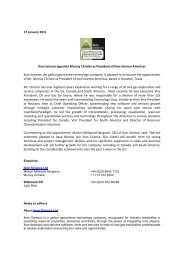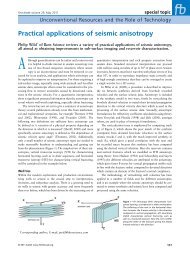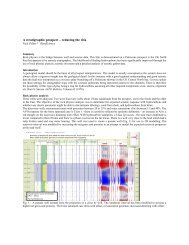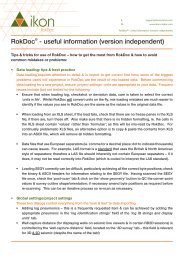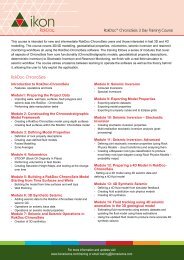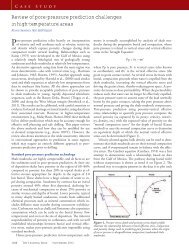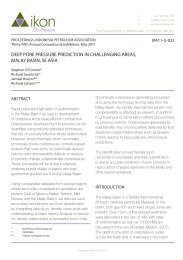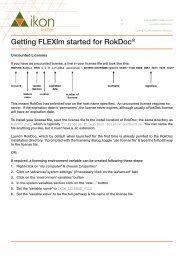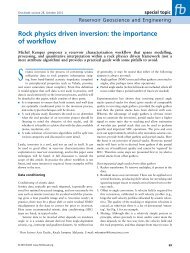Downloaded - Ikon Science
Downloaded - Ikon Science
Downloaded - Ikon Science
You also want an ePaper? Increase the reach of your titles
YUMPU automatically turns print PDFs into web optimized ePapers that Google loves.
Africa<br />
A more challenging predrill prediction environment occurs<br />
at depths at which temperatures exceed a threshold where<br />
thermal processes can create additional overpressure as well<br />
as change sediment properties used in routine approaches to<br />
pressure prediction. The deeply buried Jurassic/Cretaceous<br />
source rocks along the West African margin, in particular at<br />
temperatures in excess of 160°C, are prone to generate gas.<br />
Gas requires a higher volume than oil or water and hence increases<br />
the pressure on generation. Increases in pressure reduce<br />
the effective stress (the difference between the pore fluid pressure<br />
and the minimum stress required to fracture the rock), a<br />
sediment property used in pore-pressure prediction. There is<br />
a tendency to underpredict pore pressures if this effect is not<br />
recognized. Similarly, at temperatures in excess of 100–120°C,<br />
there are many processes, for typical burial rates, which modify<br />
shale properties (such as clay-mineral transformation of<br />
smectite to illite) that once again challenge the premises used<br />
to estimate pore pressures ahead of the bit. In areas, such as<br />
offshore Angola, where thick and sometimes mobile salt is<br />
present, pore pressures can be extremely difficult to predict,<br />
because seismic imaging is poor, both for structure and the<br />
velocities used in predrill prediction techniques. The amount<br />
of pressure found beneath salt largely depends on the extent<br />
of the salt as a rock unit and the ability of the salt to trap fluid<br />
beneath. Fluids can escape where salt is absent if there are sufficient<br />
volumes of connected reservoirs to allow high-pressure<br />
fluids to flow around the salt bodies.<br />
Summary<br />
Continental margins are characterized by geological conditions<br />
that favor development of high-pressure reservoirs, except<br />
where there is an overabundance of reservoirs, such as<br />
in the Niger Delta. Even here, deeply buried reservoirs can<br />
have extremely high pressures. There are multiple overpressure<br />
mechanisms operating simultaneously both in the shallow<br />
section (inability of water to escape from rapidly buried, finegrained<br />
sediments) and in the deep section (gas generation and<br />
changes in sediment fabric because of diagenesis). In all cases,<br />
the pressures found in reservoirs are closely related to the connectivity<br />
of reservoirs both vertically and laterally along and<br />
down the margin. High connectivity permits fluids to escape,<br />
while isolated reservoirs will maintain the pressures being generated<br />
in the surrounding fine-grained rocks. Regional mapping<br />
of overpressures along the West African margin, as being<br />
done in the current Niger Delta pressure study, has the potential<br />
to reduce drilling risk by illustrating pressure distributions<br />
as well as reducing the exploration risk associated with trapping,<br />
both conventional and hydrodynamic.<br />
References<br />
Bowers, G. L., 1994, Pore pressure estimation from velocity data: accounting<br />
for overpressure mechanisms besides undercompaction:<br />
SPE paper 27488.<br />
Bowers, G. L., 1995, Pore pressure estimation from velocity data:<br />
Accounting for overpressure mechanisms besides undercompaction:<br />
SPE Drilling and Completion, 10, no. 2, 89–95,<br />
doi:10.2118/27488-PA.<br />
Chopra, S. and A. Huffman, 2006, Velocity determination for pore<br />
pressure prediction: CSEG Recorder, April 2006, 28–46.<br />
Dickenson, G., 1953, Geological aspects of abnormal reservoir pressures<br />
in Gulf Coast Louisiana: AAPG Bulletin, 37, 410–432.<br />
Ellenor, D. W., 1984, quoted in The geology and hydrocarbon resources<br />
of Negara Brunei Darussalam: Brunei Shell Petroleum<br />
Company.<br />
Pressure study for Nigeria, Offshore, 2010, http://www.offshore247.<br />
com/news/art.aspx?Id=16868.<br />
Swarbrick, R. E., M. J. Osborne and G. S. Yardley, 2002, The magnitude<br />
of overpressure from generating mechanisms under realistic<br />
basin conditions; in: Pressure regimes in sedimentary basins and<br />
their prediction, A. R. Huffman and G. L. Bowers, eds. AAPG<br />
Memoir 76, 1–12.<br />
Swarbrick, R. E., R. Lahann, S. O’Connor, and A. Mallon, 2010, Role<br />
of the chalk in development of deep overpressure in the Central<br />
North Sea, in B. A. Vining and S. C. Pickering, eds., Petroleum<br />
geology from mature basins to new frontiers: Proceedings of the<br />
7th Petroleum Geology Conference, volume 1, 493–507.<br />
Acknowledgments: GeoPressure Technology (an <strong>Ikon</strong> <strong>Science</strong> company)<br />
and its Nigerian partner Sonar Limited are currently engaged<br />
with the Nigerian federal authorities, DPR and Napims, and with<br />
a group of six sponsor companies, in mapping pressures across the<br />
Niger Delta. Phase 1, covering the deepwater and ultra-deepwater<br />
areas was due to be completed in April 2011. Phase 2 (continental<br />
shelf and near-shore areas) and Phase 3 (onshore and swamp) will<br />
be completed between 2011 and 2014.<br />
Corresponding author: r.e.swarbrick@geopressure.co.uk<br />
<br />
June 2011 The Leading Edge 687<br />
<strong>Downloaded</strong> 08 Jul 2011 to 195.99.165.130. Redistribution subject to SEG license or copyright; see Terms of Use at http://segdl.org/



